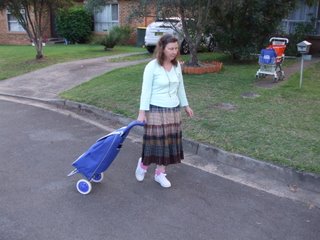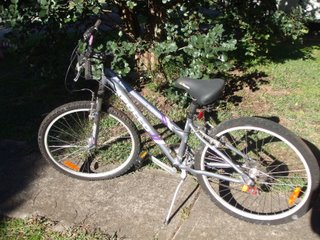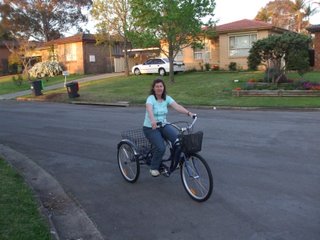For the last ten years or so I have had a company car and for at least the last five it has been our only car, thus when I was retrenched a few months ago we were left without a car at all. Rather than jump back into the world of motoring again, with all its associated costs, we decided to save our pennies and buy a car again only when I needed it for work. In the mean time I have returned to my roots; my father never having owned a car since before I was born and I was in my mid teens when my brother first bought a car. So you can see that for a long time in my formative years I was well acquainted with the sustainable forms of transport like public transport and shank’s pony.
However, the world and my circumstances have changed a bit since those days so I thought that by describing how things have worked for us it might give you something to think about if you decide to head down this route.......willingly or not.
Location, Location, Location
No, not the TV show! You may consider it luck, while I rather think it is good management on my part, but a whole stack of places we need to get to on a regular basis are within easy walking distance, such places as –
• Shops
• Our bank
• Family doctor
• Dentist
• Church
• Schools, although with both kids having grown up and moved out this one is no longer so important for us.
And there are buses to a number of comparatively major centres and several train stations that leave from outside our local shops. So if you do decide (or are forced) to ditch the car, have a think about those places you absolutely must get to, and see what alternative ways there are of getting there.
Walking
A much underrated means of locomotion. Slow but sure, it keeps you fit and requires the burning of no fossil fuels, just the food you would be consuming anyway. Admittedly you can carry as much as you can when driving a car, but it is surprising how much you can carry so having a backpack can be a good thing if you intend to pick up stuff and walk it home. This is Australia so if you are doing serious walking make sure you have a good wide brimmed hat, not a stupid baseball cap that doesn’t protect your ears or the back of your neck, sunscreen and a good pair of sunglasses. In Asia I have seen ladies walking on a sunny day with an umbrella up to keep the sun off them and my lovely partner in the sustainable life uses this technique today, the Cancer Council sun umbrellas are particularly protective. Remember that clouds are no barrier to ultraviolet radiation so cover up even on cool cloudy days.
Also make sure you take a supply of water with you, as walking on even a dull day can dehydrate you before you know it, especially if you are not acclimatised to doing it. Let’s face it, after being a desk jockey for over fifteen years and my main exercise consisting of cutting the lawn on the weekend, I needed to get used to walking everywhere again myself. Being a shiny bum isn’t all it’s cracked up to be.
Shopping Carts, shopping jeeps, Grocery prams and the like.

One way of increasing the amount of gear you can haul while walking without spending outrageous lumps of cash is to invest in a two or four wheeled shopping cart or make yourself a grocery pram (see another article in this section). Shopping carts, once the preserve of old ladies.......and still are to a certain extent....are increasing in popularity again. It wasn’t so long ago that the only place you would find one was second hand at the salvation army or Vinnies, but they have been rebadged as “enviro trolleys” or “Eco carts” or whatever to cater to the green market. This is a good thing because they have become available again, but be aware that some are pretty rubbishy and most do not have the quality of the ones of years gone past so inspect closely before you buy. An even cheaper option is to get a second hand baby stroller and turn it into a grocery pram, so consult our other article if you want to go that way.
Bike it!
This is a bit more expensive, but there are still some bargains to be had especially if you get an old second hand bike and fix it up. This has a spin off in teaching you how to maintain and repair your own bike, a handy skill at any time. You occasionally come across bike maintenance courses at TAFE or the local community college and these are well worthwhile, otherwise get yourself a good book on bike repair and maintenance. A minimal number of tools and a small stock of spares will enable you to keep your two wheeled mate tootling along and give you years of trouble free pedalling.
As always, make sure you know and follow the road rules and have and use a good quality brain bucket, skid lid or stack hat. I am speaking from experience here, having wound up on my neck in the gutter after a close encounter with a car, so don’t tell me you look like a dork, just wear the bloody thing.
If you have a bit more money or are techo you could buy or build a powered bike, usually pushed along by a small electric or petrol motor. In Australia if the motor on your bike does not produce in excess of 200 watts it is still regarded as a push bike rather than a motor bike and no license is required. I was lucky and there was a comparatively inexpensive one going a few Decembers ago, guess what I got for Christmas that year. It is electric and I keep it charged by the 12volt system through a square wave inverter, but before I plugged it in I rang the manufacturer to ensure that the square wave inverter would not do anything terminal to the charger, they said it would be OK and it was. If you are in the same situation don’t take my word for it, check yourself!
Another advantage of an assisted bike (electric or petrol) is that extra assist up hills makes it easier on the unprepared body. While walking is great and gets you where you want to go it will not adequately prepare you for the rigours of biking, particularly uphill! So start out slow and work up to it.
To further increase your carrying capacity you can buy or build a bike trailer. While I intended to build one I was able to get hold of a commercial model at a reasonable price so I wound up buying one. I must admit that I don’t have a huge amount of experience with it yet but it will be getting a work out soon. Our local hardware is about an hour’s walk away and I will need the bike trailer to bring home some of the bulkier and heavier stuff for my projects.
Next rung up the totem pole is the adult tricycle, which come in pedal power and pedal electric. I bought a pedal powered one for my lovely partner in the sustainable life, the electric ones being just too expensive. It has a reasonably sized basket and we have both used it to haul gear and ourselves, making trips that would have been difficult and time consuming on foot much easier. I must admit that even though it only has three hub gears it is a huge amount of fun to ride, but it is hers rather than mine so she gets to use it before I do.
Public Transport
I must admit, I didn’t know just how far, or where I could get to on public transport until I needed to. It had been many years but thank heaven it was still there waiting for me. OK it does have its disadvantages; it’s not door to door, it takes longer and after dark there can be some security issues but it saves you cash on owning a car, you can’t run a speed or red light camera, it’s more sustainable and strangely enough connects you more with your community. Each of us living in our own little car-centric worlds tends to keep us apart from our neighbour; public transport gets us out and communicating with fellow commuters even if it is just to bitch on how poor the service is. Truthfully though public transport does give opportunities to meet people than being stuck by ourselves in our cars and that can be quite fulfilling.
It does take more time to use public transport and that’s why it is important to plan, and to get hold of the timetables for the buses, trains or ferries you will be using, particularly if you will be using more than one service so you can be sure the connections will line up. Studying the timetables (mostly accessible and printable off the net) is no guarantee you won’t be stuck in a bus shelter or on a train station somewhere, waiting for the next one, but it gives you a better chance of a smooth trip.
Planning
While we have found being without a car is not as bad as it might be, we can’t just jump up and drive off somewhere whenever we feel like it. Our trips out require more planning and when public transport is involved, more time – so it is important to get the most out of each trip even if you are just walking down the shops to pick something up.
Make a list – this is important to help you maximise each trip, particularly if you are going somewhere a bit difficult to get to. We have reached an age where it is quite possible to forget why you entered a room, when you knew absolutely before you walked in let alone miss something on a shopping trip. Anyone can have a lapse of memory so write down all things you want to do/pick up on your expedition and you will be sure that there will be no need for loud swearing about forgotten items when you get home.
Keep a stock – all of those consumables like eggs, sugar, flour as well as nails, screws or even cleaners like soap or bleach or that necessity of all necessities; toilet paper – we take them for granted but it can be intensely annoying when we run out. It may be some time before it is convenient to get out to pick them up, so when you do buy them buy a bit more than you would normally and store the excess away in a cupboard, to be dragged out when there is a panic that you may have run out.
Do a milk Run – When you are out and about, see if you can plan for your activities and things you need to get to be in the same rough geographical area. That way you will be able to accomplish the most on each trip that you make, hopefully reducing the overall number of trips needed saving you time and money.
Getting hold of a Car
Relatives - OK, so you are without a car, it is cheating but you may be able to con your relatives into providing a taxi service. I wouldn’t count on it all the time but in emergencies or for special occasions a nearby relative can be very handy. Our daughter and son in law live about 20 minutes down the freeway from us and this is both good and bad (good for us – bad for them) so we will occasionally ask for their help and they are pretty good at providing it.
Hire – There are occasions such as wanting to get some place difficult to access by other means or where you need to pick up something heavy or bulky and it is difficult to do it any other way, hiring a vehicle may be the answer. You are only paying for the vehicle for that particular activity or trip so that in the long run it will work out much cheaper than having to buy, maintain and fuel a vehicle of your own.
Conclusion
So, if you were wondering, there is life after car! Whether it will be a full time or temporary arrangement, whether it was by choice or forced upon you, the car free life is still a full one. It is more sustainable, cheaper, and very satisfying when everyone starts complaining about the price of fuel. So make your plans and go for it!


